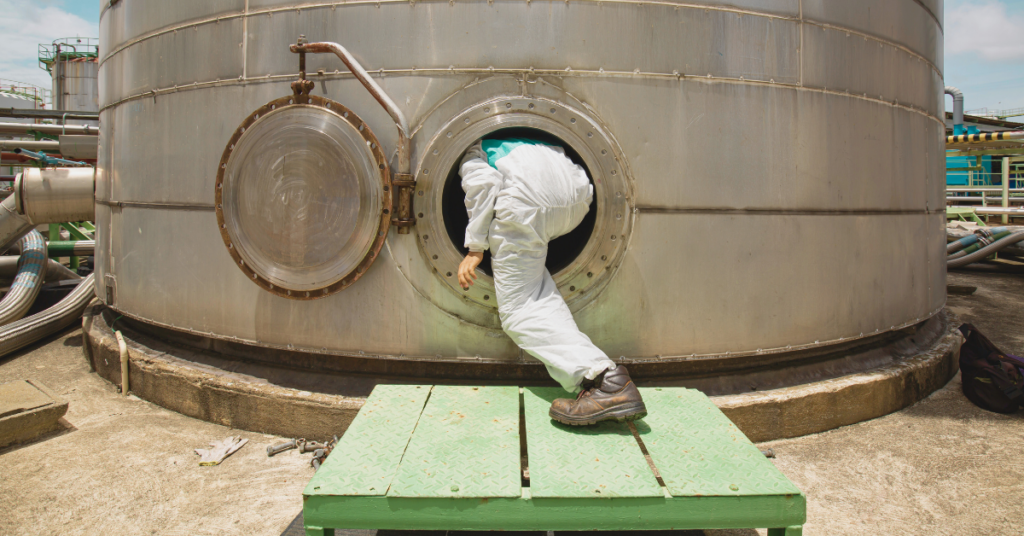Confined spaces can pose significant risks and hazards to workers if proper precautions aren’t taken. At ACE Environmental, we prioritize safety, and we’ll highlight potential hazards and the essential safety measures implemented by ACE Environmental on all our Confined Space Entry projects.
Defining Confined Spaces:
Confined spaces are areas with limited entry and exit points, inadequate ventilation, and potential hazards. They can include storage tanks, manholes, frac tanks, pipelines, elevator shafts, and a variety of other enclosed structures. It’s crucial to recognize these spaces’ potential dangers and treat them with utmost caution.
Assessing and Identifying Potential Hazards:
Before entering a confined space, a thorough assessment must be conducted to identify potential hazards, such as toxic gases, lack of oxygen, flammable substances, unstable structures, or mechanical risks. ACE Environmental’s trained professionals conduct comprehensive evaluations to ensure all risks are identified and mitigated. Here are examples of the potential hazards confined space entry projects pose:
Lack of Oxygen: Insufficient oxygen supply can lead to asphyxiation due to gases, vapors, or poor ventilation.
Toxic Atmospheres: Confined spaces may contain hazardous gases, chemicals, or fumes that pose risks to respiratory health or even fatalities.
Engulfment: Spaces like silos, frac or storage tanks can contain materials that can engulf a person, leading to suffocation or crushing injuries.
Fire and Explosions: Accumulation of flammable substances or inadequate electrical systems can result in fire or explosions, endangering workers.
Physical Hazards: Obstacles, narrow passageways, or unstable structures can cause falls, injuries, or entrapment.
Implementing Safety Measures:
To ensure the safety of workers involved in confined space entry, several measures should be implemented:
Develop a written confined space entry program: This program outlines procedures, responsibilities, and safety protocols specific to each confined space, ensuring consistency and providing guidelines for all personnel involved.
Proper Training: Workers receive thorough training on confined space entry procedures, hazard identification, proper equipment usage, effective communication tools, and emergency response protocols.
Risk Assessment: A detailed assessment of the confined space is conducted to identify potential hazards and develop appropriate control measures.
Entry Permit System: Implement an entry permit system that requires authorization before entering a confined space. This ensures that safety procedures are followed and proper precautions are taken.
Continuous Atmospheric Monitoring & Ventilation: Regularly monitor the confined space atmosphere throughout the entry process to detect any changes in oxygen levels, toxic gases, or flammable substances. Adequate ventilation is provided to ensure a sufficient oxygen supply and remove any toxic or flammable substances.
Personal Protective Equipment (PPE): Workers wear appropriate PPE, such as respiratory protection, fall protection, and protective clothing, based on identified hazards.
Communication and Monitoring: Establish effective communication systems and continuous monitoring to maintain contact with workers inside the confined space and promptly respond to emergencies.
Importance of Proper Training and Expert Assistance:
Confined space entry demands meticulous planning, comprehensive hazard assessments, and strict adherence to safety measures. At ACE Environmental, we emphasize the importance of educating our clients on the intricacies of confined space entry to mitigate risks and ensure the well-being of your personnel. By understanding the hazards, implementing proper safety protocols, and prioritizing ongoing training, we can navigate confined spaces with confidence, eliminating the risk of potential incidents.
To learn more about our confined space services and how ACE Environmental can assist you, please visit our website or give us a call at (410) 354-8030. Your safety is our top priority, and we’re here to provide the expertise and support you need.
Stay informed, stay safe.

